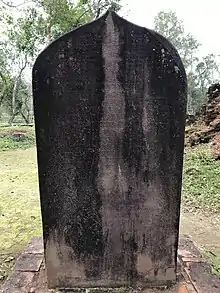Vikrantavarman I
Vikrāntavarman I or Jaya Prakāśadharman (?–686 AD), was the sixth King of the Fourth dynasty of Champa, modern-day Central Vietnam, reigned from 653 to 686. He was the son of Prince Jagaddharma, the grandson of Kandarpadharma, and Princess Sarväpi, daughter of king Isanavarman I of Zhenla. He sent embassies to the court of Emperor Gaozong of Tang in 653, 654, 669, and 670, which he was known as Zhu Ghedi (諸葛地) and Bojiashebamo (鉢伽舍跋摩, Late Middle Chinese: pɑt-kaɨ/kɛ:-ɕia’/ɕiaʰ-bɑt-mɑ), as recorded in the New Book of Tang. He was known for expanding the Cham kingdom to the south, and was often confused with king Prabhāśadharman (r. 640–645) whos reigned 20 years prior.
| Vikrāntavarman I | |||||
|---|---|---|---|---|---|
| Raja-di-raja | |||||
| King of Champa | |||||
| Reign | 653-686 | ||||
| Coronation | 653 | ||||
| Predecessor | Bhadresvaravarman | ||||
| Successor | Naravāhanavarman? then Vikrantavarman II | ||||
| Born | ? Simhapura, Champa | ||||
| Died | 686 Simhapura | ||||
| Consort | Isanavarman | ||||
| Issue | Vikrantavarman II | ||||
| |||||
| House | Fourth dynasty (Rudravarmans dynasty) | ||||
| Father | Jagaddharma | ||||
| Mother | Sarväpi | ||||
| Religion | Hinduism, Buddhism | ||||
During his reign Vikrantavarman built temples worshiping Kandarpadharma (the father of his grandfather's mother?), for Śiva's friend Ekākṣapiṅgalā? Kuvera at Mỹ Sơn,[1][2] dedicating for Amareśa;[3] and a golden portrait of Śiva.[4]

References
- Golzio 2004, pp. 9–10.
- Majumdar 1927, p. 27.
- Majumdar 1927, p. 15.
- Majumdar 1927, p. 36.
Bibliography
- Majumdar, R. C. (1927), Champā: History and Culture of an Indian Colonial Kingdom in the Far East, 2nd-16th Century AD, book III, Gyan Publishing House
- Golzio, Karl-Heinz (2004), Inscriptions of Campā based on the editions and translations of Abel Bergaigne, Étienne Aymonier, Louis Finot, Édouard Huber and other French scholars and of the work of R. C. Majumdar. Newly presented, with minor corrections of texts and translations, together with calculations of given dates, Shaker Verlag